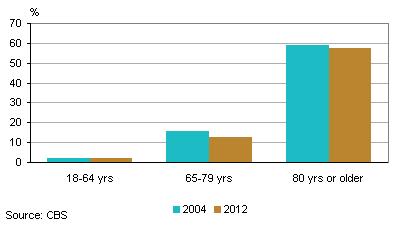Fewer over-65s receive long-term care services

Statistics Netherlands announced today that nearly 950 thousand persons received long-term care in 2012. Due to the ageing population, the number of long-term care recipients has increased dramatically over the period 2004-2012. Because the over-65 population has grown more rapidly than the number of long-term care consumers, the share of over-65 long-term care recipients has declined. Spending on long-term care also increased in 2013, to 4.6 percent of the GDP.
Nearly 7 percent receive long-term care
This year, 848 thousand people aged 18 years and older received long-term care in kind; a personal contribution has to be paid for this type of care service. Over the period 2004-2012, the number has risen by 11 percent to 942 thousand, i.e. 6.9 percent in the population.
In 2012, 570 thousand persons only received care at home, 276 thousand only received care in institutions and 96 thousand received both types of care.
Persons receiving long-term care (excluding counselling)

Nearly six in ten over-80s receive long-term care
Most long-term care consumers are in the older age categories; 13 percent of 65 to 79-year-olds and 58 percent of over-80s, for example, received this type of care, as against 2 percent of 18 to 64-year-olds.
The number of over-65 long-term care recipients has grown from 654 thousand in 2004 to 728 thousand, but the population in this age category has grown more rapidly. Proportionally, many people in the over-65 population have only recently reached the age of 65, the so-called baby boom generation. As a result of this demographic development, the share of over-65 long-term care consumers was reduced.
Among 65 to 79-year-olds, the share was reduced from 15.7 to 12.7 percent and among over-80s from 59.1 to 57.6 percent. The reduction occurred in care provided at home and care provided in institutions; only the share of over-80s receiving care at home increased marginally.
Share long-term care consumers by age (excluding counselling)

Spending on long-term care services accounts for nearly 5 percent of the GDP
Total spending on long-term care soared by 40 percent from 21 billion euros in 2004 to 29.5 billion euros in 2013, i.e. 4.6 percent of the GDP and much more than the overall amount spent on hospital care (24.8 billion euros). In 2004, 4.1 percent of the GDP was spent on long-term care.
Care in kind provided under the Exceptional Medical Expenses Act (AWBZ) constitutes the bulk of long-term care expenditure. Spending on care in kind rose from 20.4 billion euros in 2004 to 25.2 billion euros in 2013. Spending on personal budget care under the AWBZ more than tripled from 0.7 to 2.5 billion euros in the period 2004-2013. Spending rose sharply in 2012 as a result of the 5 percent rate increase introduced on 1 January 2012 for people with an indication for institutional (intramural) care. Approximately 1.7 billion euros was spent in 2013 on home care under the Social Support Act (Wmo). The amount involved in the year that the Wmo was introduced (2007) was approximately 1.4 billion euros.
Long-term care expenditure
